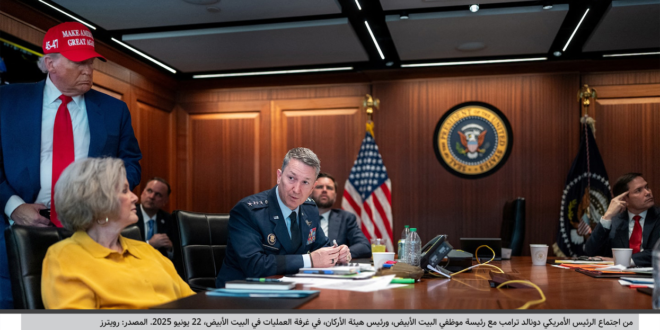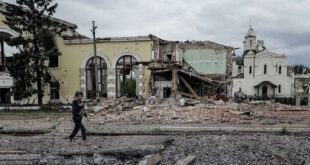The United States’ direct entry on the military frontline against Iran, via the June 22, 2025 precision air strike on central nuclear facilities, is a strategic turning point in the balance of power, pushing Iran to a crucial crossroads between containing the escalation or going towards an open confrontation, amid rising regional tensions and fears of a multi-arena war.
The United States entered the line of Israeli military operations against Iranian capabilities, in a qualitative and unprecedented development after it carried out on June 22, 2025, a military strike against Iran targeting three central nuclear facilities: Fordow, Natanz, and Isfahan. In an operation carried out using long-range American B-2 stealth bombers and high-precision Tomahawk missiles. U.S. President Donald Trump said the strike destroyed all-fortified enrichment facilities, especially the Fordow facility in a heavily fortified mountainous area near the city of Qom, using fortification-piercing bombs. This strike came in the context of the Israeli-Iranian attacks since June 13, and comes as the most escalatory event against Iran, and raises regional and international concerns about the shape of the next escalation, especially with Iranian threats to respond, which may include targeting US bases and interests spread in the Middle East. What could get the region into a multi-area war.
Accumulative indicators and preliminary facts
The US strike on Iranian nuclear facilities came in an expected context within the tracks of the Israeli military operation against Iranian capabilities, which began with targeting the leaders of the Revolutionary Guards and nuclear scientists, and expanded to include Iranian missile capabilities and air defense systems. The scope of these operations extended from northern Iran during the first week, towards the center of the country, specifically Isfahan, with the expected coverage of the east and south of the country. The U.S. strike marks a critical turning point in the course of the “almost direct” negotiations between the United States and Iran, the first of which began on April 12, 2025, and continued until the postponement of the sixth round after the Israeli strikes. Before witnessing the signs of its resumption on June 21, an inconclusive round of European negotiations between Iranian representatives and representatives of Britain, France and Germany, but failed to reach understandings or make a real political breakthrough in the nuclear file.
In fact, the signs of the U.S. strike have been remarkable, with the United States intensifying its military buildup in the region in an unprecedented manner, particularly from long-range strategic bombers, and carrying out strikes against the Houthis in Yemen, during March 2025, which were estimated as the operational beginning of a new war against Iran. To the stage of direct preparation of the strike, where U.S. forces increased their level of readiness by enhancing the deployment of their B-2 and B-52 strategic bombers at the Diego Garcia base in the Indian Ocean, followed by the movement of the aircraft carrier USS Nimitz from the South China Sea to the Arabian Sea. The alert status has also been raised at a number of key U.S. bases within the scope of responsibility of U.S. Central Command (CENTCOM), along with the strengthening of defense capabilities in those bases. In conjunction with reports of partial evacuation of non-essential workers at some U.S. military and diplomatic sites, in anticipation of possible Iranian retaliatory attacks, was seen as a clear field indication of an imminent and strategic confrontation approaching. US President Donald Trump stated on June 19 that Iran is just steps away from making a nuclear weapon, and it is possible for domestic and global public opinion to move militarily against it. US President Donald Trump stated on June 19 that Iran is just steps away from building a nuclear weapon, noting that time is running out, and he has only two weeks before taking decisive military action.
Difference in statements about damages
The talk after the US strike focused on its results and impact, as US President Donald Trump considered it “very successful”, stressing the complete elimination of the three nuclear facilities, and Chairman of the US Joint Chiefs of Staff Dan Kane stressed that the preliminary assessment shows serious damage to the targeted Iranian facilities. While Iran acknowledged the attack, but downplayed the damage, especially at Fordow’s uranium enrichment facility, an adviser to the speaker of Iran’s parliament said the sites had long been evacuated, and that the damage was “repairable” and did not amount to catastrophic losses.
The United States is focusing on the state of targeting the same fortified nuclear infrastructure, which is highly likely to be severely damaged as a result of the U.S. use of powerful GBU-57 fortified fortification bombs weighing 13.5 thousand kilograms, with a warhead weighing 2,700 kilograms, capable of penetrating about 18 meters of reinforced concrete.
In theory, the dropping of successive bombs allows deeper incursion into the facility, and reports indicate that the United States used six bombs in its strike on the Fordow facility, with a total weight of about 82 thousand kilograms, which is likely to reach the depths of the underground fortified facility, or at least the accumulation of destruction above the physical and technical structure of the reactor, which means damage and inaccessibility. From this perspective, denying that the facility was severely damaged may not be accurate, especially since it is designed to resist conventional bombs, not fortification-piercing bombs. However, confirming the extent of the actual damage requires comprehensive and complex debris removals to reach deep underground facilities, which may take weeks and possibly months to assess.
In contrast, Iran focuses on its apparent assessment on other aspects, most notably nuclear assets from its stockpile of enriched and highly enriched uranium and perhaps the most advanced IR-6 centrifuges, where it announced that it had cleared sensitive material from the three nuclear sites targeted before the strike, in an apparent attempt to minimize strategic losses and reduce direct nuclear risks. In a sign of this, satellite reports and satellite images after the end of the US strike showed the movements of unusual activity of specialized transport trucks in the vicinity of the Fordow facility two days before the strike was carried out as an indication of Tehran’s transfer of highly enriched uranium materials. This is one of the factors that contributed to avoiding a radiological and environmental disaster whose repercussions could have exceeded the borders of Iranian territory, with Iran, Saudi Arabia and the International Atomic Energy Agency (IAEA) confirming that no rise in radiation levels was recorded after the attack. This may indicate the possibility of indirect and undeclared intelligence or diplomatic contact between the two sides, as a US security warning to avoid radiation leakage, reinforcing the hypothesis that Washington wanted to send a deterrent message in a decisive and deliberate blow to avoid a humanitarian catastrophe
Next Step Scenarios
The recent U.S. military operation puts Iran at a crucial crossroads between two main options:
The first option is to contain the strike and work to end the war and gradually calm down on the ground, in order to avoid a comprehensive escalation that threatens the stability and survival of the regime, as Tehran realizes today that it has lost the ability to deter or provide an equivalent response to the size of the strikes, whether at the operational level, after losing the role of its arms in the region, especially the Lebanese Hezbollah, or the result of the Houthi-American agreement concluded in March 2025, which stipulated a mutual cessation of attacks. The limited Iranian response to Israeli strikes within its territory, despite Tehran’s disclosure of qualitative missiles capable of penetrating defense systems, did not achieve actual strategic deterrence, at a time when Israel continued to carry out its operations accurately against its pre-defined target bank, which paved the way for Washington to intervene directly by targeting nuclear facilities.
The second option is for Iran to go towards escalation, according to two scenarios based on the order of Iranian internal priorities, which is to separate the US attacks from the basic framework of confrontation with Israel, or to respond by considering the US and Israeli strikes as one front against it.
The first scenario: Separating U.S. attacks from the basic framework of confrontation with Israel
This means that the Iranian response against the American attacks will come separate from its daily attacks in the framework of the confrontation with Israel, as Iran is likely to direct limited and perhaps symbolic strikes against American bases and interests, and in a way that does not require a broader American involvement in the scene, similar to its retaliatory response in 2020, after the US assassinated the commander of the Quds Force of the Iranian Revolutionary Guards, Qassem Soleimani, when it targeted the base of Ain al-Assad, which includes US forces in northern Iraq.
This is likely to avoid targeting the American bases deployed in the region, especially those located in the Arab countries with which Tehran seeks to maintain diplomatic relations, under its current circumstances, whether at the level of calm or mediation efforts. Iran’s options for an Iranian response to U.S. forces may be moving toward search for targets that are unlikely to bring about large-scale regional intervention, such as in Iraq or Syria, and strikes may be directed at U.S. forces that fall under the responsibility of U.S. Africa Command (AFRICOM) to avoid a direct escalation in the Middle East. Iran may go to the threat of international trade in the Strait of Hormuz by targeting or controlling ships linked to the United States, but without disrupting the movement of navigation in the Strait, in order to avoid changing the position of its allies towards it due to the repercussions of the complete closure of the Straits, led by China.
In this scenario, the Iran-Israel confrontations may continue away from limited U.S. interference in its objectives of targeting nuclear facilities. By continuing to follow its military tactic based on obstructing the pace of Israeli escalation against it, Iran launched a missile attack on northern and central Israel with about 40 missiles, within the 20th wave of Operation True Promise 3. However, U.S. strikes could push Tehran to increase military pressure on Israel, whether by carrying out more precise and effective qualitative strikes, or by introducing advanced missile systems in its upcoming attacks. The latest strike has already revealed a qualitative shift in this direction, as Iran used the Khyber missile for the first time, a missile carrying a 2-ton warhead, and is characterized by high maneuverability.
This scenario is reinforced by the priority of maintaining the security of the Iranian regime and its survival and Iran’s national security, at this complex and sensitive stage, higher in its levels than going towards an unlimited escalation that may result in expanding Israeli and American goals towards regime change or undermining its internal control, by continuing to target Iranian national interests.
On the other hand, Iran still retains within its strategic calculations the possibility of keeping the door to negotiations open with the United States on the nuclear assets it still maintains, foremost of which is the stockpile of enriched uranium, such as negotiating Iran’s retention of this stockpile either in the territory of a third country, as stated in the proposal of Witkov, which was rejected by Tehran during the recent talks with Washington, or allowing it to remain the program inside Iran itself, but under the direct supervision of a third party may be European, keeping the minimum gains within the peaceful threshold (3.76).
The second scenario: Responding to consider the US and Israeli strikes as one front against them
Iran’s integration of US strikes and Israeli attacks into one front means that the country is moving to declare a state of war and emergency, including directing the country’s capabilities and human capabilities to serve military purposes, and imposing marital provisions, especially since the continuation of Israeli military operations after the US strike means that Israel’s goals have expanded beyond the end of the nuclear program, by undermining the regime’s capabilities to maintain its internal cohesion, at a time when the country is suffering from extensive penetration operations that made it easier for Israel to carry out its strikes in the Iranian depth and target senior leaders in its military leadership, amid fears that these breaches have included the political structure in the country, and that the Israeli and American goals are integrated in the direction of paralyzing the regime’s military, nuclear and security capabilities.
Within this scenario, Iran may be moving to take escalatory measures that include military strikes targeting US bases in the region, such as the Gulf States, or the participation of its arms in the region, especially those who have relatively maintained their strength, such as the Houthis in Yemen, and Iraqi armed factions, which are active on a close contact with the US military presence. Other options may include going towards closing the Strait of Hormuz, disrupting navigation in it, or planting it with naval mines, which take several years to remove, leading to a complete disruption of the movement of trade through the Strait, which amounts to more than 20% of the total global oil and gas trade transported by sea on a daily basis, and 22% of the basic strategic goods, and in the framework of the Iranian threat, the Iranian parliament agreed to close the Strait of Hormuz after being subjected to US strikes, but the final decision on implementation is subject to the approval of a security body, the National Security Council of Iran. In this scenario, Iran is likely to direct strategic and qualitative strikes against energy and petrochemical-related targets directly against Israel, and indirectly against Western and Arab interests from Israel’s energy facilities.
Finally, Iran’s options and possible scenarios of response involve a series of repercussions that threaten the stability of the political system itself. Containing the U.S. strike without a counterbalance could expose the regime to a wave of domestic popular accountability and weaken its position against opponents and critics who may see it as incapable of defending national sovereignty. The trend towards a comprehensive escalation carries with it greater strategic risks, foremost of which is the possibility of an expansion of US military intervention at home, which may lead to an existential threat to the regime. In both cases, Iran’s political system seems to be going through one of its most “fateful” moments since the founding of the Islamic Republic, with a fragile balance between deterrence and exposure, and between survival and forced change.
 Eurasia Press & News
Eurasia Press & News




